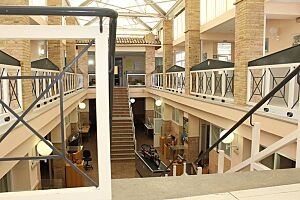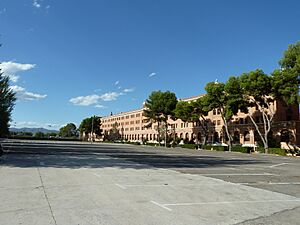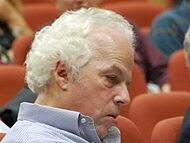CEU Cardinal Herrera University facts for kids

Seal of CEU Cardenal Herrera University
|
|
|
Former names
|
Centro Universitario San Pablo affiliated to the University of Valencia, University of Alicante and to the Polytechnic University of Valencia (1969–1999) Universidad CEU Cardenal Herrera (1999–) |
|---|---|
| Type | Private |
| Established | 1970 |
| Chancellor | Vicente Navarro de Luján |
|
Academic staff
|
1,222 |
| Students | 9,250 |
| Undergraduates | 8,198 |
| Postgraduates | 1,052 |
| Location |
,
Spain
|
| Campus | Valencia, Castellón and Elche |
| Newspaper | El Rotativo |
| Affiliations | CEU Foundation EHEA Erasmus Programme Karolinska Institutet |
CEU Cardenal Herrera University (in Spanish: Universidad CEU Cardenal Herrera) is a private university in the Valencian Community, Spain. It is part of the CEU Foundation. This university was the first private school of Law ever started in Valencia. It has been connected to the University of Valencia and Polytechnic University of Valencia since the early 1970s. The university got its current name in 1999.
The university has five main areas of study, called faculties:
- Faculty of Health Sciences
- Faculty of Veterinary Medicine
- Faculty of Law, Business and Political Science
- Faculty of Humanities and Communication Sciences
- Technical School of Design, Architecture and Engineering (ESET)
CEU UCH offers degrees in English, French, and Spanish. You can study subjects like architecture, veterinary medicine, dentistry, and nursing. The university has three modern campuses. These are located in Alfara del Patriarca (near Valencia), Elche (Alicante), and Castellón. Over 9,250 students from all over the world study here. About 35% of its students come from other countries.
International rankings show CEU UCH as one of the top Spanish private universities. For example, the Academic Ranking of World Universities (ARWU) placed it as the second-best Spanish private university for research in 2013. This was after the University of Navarra. In 2014, U-Multirank, a global university ranking, placed CEU-UCH as the tenth European university for its local involvement, scientific work, and international focus. The THE World University Rankings have also included CEU among the best universities globally in 2021 and 2022.
Contents
University History
The university is managed by the San Pablo CEU University Foundation. This foundation is the largest private education group in Spain. It also runs two other universities and many primary and secondary schools. CEU UCH has been linked to the University of Valencia since the early 1970s. Its history began in 1971 when the first private Law school opened in Valencia. The university officially became "University CEU Cardenal Herrera" in 1999. The foundation started its work in Valencia in 1971 and in Elche in 1994. The Generalitat Valenciana approved the law for its creation. It has been operating under its current name since the 2000–2001 academic year. Today, nearly 10,000 students from around the world study at the university. About 35% of these students are international.
The University Cardenal Herrera is part of the "Platon" Academic Excellence Program. This program is run by the San Pablo CEU Foundation with Harvard University. It is also part of the European Higher Education Area system. The "Platon" program aims to improve student support and continuous assessment.
What You Can Study
CEU Cardenal Herrera University has five main faculties, each offering different study programs:
Humanities and Communication
- Degrees in Journalism, Advertising, Audiovisual Communication, Sports, and Education.
Design, Architecture, and Engineering
- Degrees in Architecture and Industrial Design.
Law, Business, and Political Science
- Degrees in Law, Political Science, Marketing, and Business Administration.
Veterinary Medicine
- Degree in Veterinary Medicine.
Health Sciences
- Degrees in Physiotherapy, Nursing, Pharmacy, Dentistry, and Medicine.
Advanced Studies: Master's Degrees
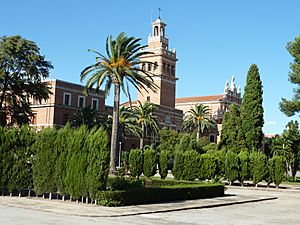
The university also offers many Master's degrees for students who want to specialize further. These programs help students become experts in their chosen fields.
Humanities and Communication Sciences
- Master in Communication and Digital Branding
- Master's Degree in Creative Advertising and Branding
- European Master's Degree in Public Relations (MARPA)
- Master's Degree in Teacher Education for Secondary Education and High School
Law, Business and Political Science
- Master's Degree in Equal Opportunities Agents (online)
- Master's Degree in Marketing
- Master in Finance
- Master's Degree in policies and tools for reducing carbon dioxide emissions.
Veterinary Medicine
- Master's Degree in Clinical Practice Management and Veterinary Centers
Technical School of Design, Architecture and Engineering (ESET)
- Master in Sustainable Architectural Design and Building Energy Assessment
- Master in Architectural Industrialisation and Prefabrication
- Master in Engineering Design
- Master's Degree in Technological Innovation and Technical Textiles
- Master's Degree in Fashion Design Management and Operations
Business School
- Master's Degree in Management and Project Management for Health and Social Centers
- Master in Cultural Management
- Master's Degree in Occupational Health and Safety
Health Sciences
- Master in Pharmaceutical Care and Pharmacy Care
- Master's Degree in Physiotherapy Care in Physical Activity and Sport
- Specialisation Master's Degree in Nursing Care
- Master's Degree in Neurorehabilitation
- Master's Degree in Organic Chemistry, Experimental and Industrial
- University Master in Osteopathic Manual Therapy
- Master in Orthodontics and Dentofacial Orthopedics
- Master's Degree in Applied Nutrition to Health
- Master in Food Safety
Elche Center
- Master's Degree in Teacher Education Secondary Education and High School
- Specialization Master's Degree in Nursing Care
- University Master in Osteopathic Manual Therapy
University Campuses
CEU Cardenal Herrera University has three campuses. They are located in Alfara del Patriarca (Valencia), Elche, and Castellón. The main campus in Alfara del Patriarca has important facilities. These include the central library and the International Relations Office. This campus is easy to reach from Valencia city center. There is a direct metro line (Line 1) and regular bus service. It is also near student housing. The university's new central library is a large building. It is about 5,000 square meters and can hold up to 700 students. It has computer labs, study rooms, and research rooms. You can also find audiovisual and internet resources there.
Medical students study at a new medical school building in Castellón de la Plana. This town is about an hour from Valencia. It is close to Benicàssim, a popular beach resort. Castellón de la Plana has a calm atmosphere but also offers good nightlife. The town has a large university hospital.
Student Life
Currently, about 10,000 students attend the university. Many come from different parts of Spain, like Valencia, Murcia, Majorca, Ibiza, and Albacete. Each year, about 700 international students come to study their degrees. Many others come through European exchange programs like Erasmus.
CEU Cardenal Herrera University has its own facilities for hands-on training. These include a Media Production and Multimedia Center. It has TV studios, radio stations, and photography areas. There is also a Veterinary Hospital, which is well-known in Valencia. The Zoological Faculty has different types of animals for study. The University Dental Clinic provides patient care and practice labs. Students also use labs for basic biomedical sciences. The Central Library has over 100,000 books and seats for 700 students.
The university publishes a monthly newspaper called The Rotary Diary. It also has a radio station, Radio CEU, which broadcasts for 12 hours daily. There is also a media company called CEUMedia with its own TV Channel. These are all run by students from the Faculty of Humanities and Communication Sciences.
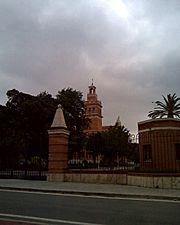
The university has many social and sports groups. There is a strong Erasmus-support group for international students. Each school has a Tuna, which is a traditional Spanish band. They compete in national competitions. There is also CEU Theatre, which helps students grow through acting.
For sports, the university offers many activities. These include aerobics, gym, yoga, tennis, diving, and tai chi. For team sports, there are male and female teams for basketball, soccer, and volleyball. Students can also play chess and table tennis. CEU UCH hosts regular sports competitions, like golf, football, and volleyball tournaments. Internal university games are held several times a year, where different schools compete.
CEU UCH also offers a Summer University in June and July. These courses help both current and new students. The International Office helps foreign students with paperwork and finding housing. They also offer Spanish language courses for international students.
University Rankings
CEU UCH has been recognized by various university rankings.
Design School Recognition
In 2012, CEU-UCH's ESET Technical School of Engineering was named the number two design school by Architectural Digest. This was in their "Top Ten section." Other top schools included Parsons The New School for Design and Royal College of Art.
El Mundo Report
The Spanish newspaper El Mundo publishes an "Spain Best Universities Annual Report." In 2006 and 2008, CEU UCH was ranked 6th overall. Its Degree in Audiovisual Communication was ranked fourth in Spain for several years (2006, 2010, 2011, 2012, and 2013). El Mundo noted that the university's facilities, small group practical work, and personal attention helped it achieve this ranking.
International Rankings
CEU UCH was highly ranked by many international university rankings in 2013.
| According to IUNE Observatory ranking | 2002 | 2003 | 2004 | 2005 | 2006 | 2007 | 2008 | 2009 | 2010 | 2011 |
|---|---|---|---|---|---|---|---|---|---|---|
| Placed in terms of Scientific publications | 4 | 4 | 4 | 4 | 4 | 2 | 4 | 3 | 3 | 4 |
| Placed in terms of scientific publications about Medicine and Pharmacology | 3 | 4 | 2 | 3 | 4 | 2 | 4 | 3 | 3 | 4 |
| Placed in terms of scientific publications about Experimental science and Life sciences | 3 | 4 | 3 | 3 | 3 | 2 | 3 | 2 | 2 | 2 |
| Placed in percentage of publications in journals | 2 | 3 | 3 | 3 | 2 | 3 | 3 | 3 | 2 | 2 |
U-Multirank, supported by the European Union, is a "multi-dimensional ranking." It looks at the performance of many universities worldwide. In its first ranking, CEU-UCH was placed as the tenth European university. This was based on its regional involvement, scientific work, and international focus. U-Multirank started on May 13, 2014.
As of 2021 and 2022, CEU Cardenal Herrera University has been included in THE World University Rankings. It scored very well for how often its research is cited and for its international outlook. It is one of the top Spanish universities in these areas.
Research and Innovation
CEU Cardenal Herrera University is involved in many research projects. These projects often work with the Generalitat Valenciana. Some research areas include studying diseases like leukemia or diabetes, and designing new medicines. The university has three research institutes: IDYCA (Institute of Addictive Behavior), IDIT (Institute of Design, Innovation and Technology), and IDEA (Institute for Environmental Law and Ethics). In July 2013, CEU-UCH and Karolinska Institutet from Sweden started a student partnership and exchange program.
Veterinary Medicine Research
- Studying hormones and diseases in farm animals.
- Research on animal surgery.
- Improving food safety in meat products.
- Studying eye health in animals.
- Research on animal parasites and diseases.
- Animal behavior and welfare.
Health Sciences Research
- Using computer methods to design new medicines.
- Research on how medicines are used and cared for.
- Studying cancer at a cell and molecule level.
- Research on brain damage and how the brain repairs itself.
- Developing new ways to apply medicines to the skin.
- Designing and creating compounds for medical use.
- Diagnosing diseases using molecular methods.
- Studying human milk: its makeup and properties.
- Research on neurodegenerative and neuroprotective processes.
- The CEU Dentistry Clinic has modern dental labs and X-ray rooms. It uses advanced technology for dental care.
Humanities and Communication Sciences Research
- Studying communication, public involvement, and environmental awareness online.
- Analyzing communication campaigns and news in the press.
- Bioethics Research Group.
- Research Group on disability and communication (GIDYC).
- Center for Research in Digital Media (OIMED).
Technical School of Design, Architecture and Engineering (ESET) Research
- Algorithms and numerical methods for large systems.
- Biomedical Engineering.
- Composites (new materials).
- Robotics and Industrial Control.
Students from ESET have participated in the Solar Decathlon competition. This is an international challenge where teams design and build energy-efficient solar-powered houses. There is a Solar Decathlon Europe as well. Students also take part in the Eco-marathon, where they build special vehicles to achieve the best possible fuel efficiency.
Law, Business and Political Science Research
- Cooperation and Development.
- Deliberative democracy, communication, and citizenship.
- Taxation and climate change.
- ADEC Group (Water: law, business, political science, and communication).
- Research Group in financial economics.
- Research Group on International Protection of Human Rights.
- Legal protection for investors in new markets.
- The region as a historical example.
- International Financial Reporting Standards in carbon markets.
- Religion and the Right to Environment.
Famous People from CEU Cardenal Herrera
Many notable people have studied or taught at CEU Cardenal Herrera University.
Famous Alumni
- Federico Martínez Roda
- María José Catalá: A Spanish politician.
- Santos González: A Spanish professional road bicycle racer who won national championships.
- Ana Milán: A Spanish actress and model, known for TV series like 7 vidas and Física o Química.
- Joana Chilet: Director of Canal Nou.
- Pepa Crespo: Director of communication for Valencia Bioparc.
- Máxim Huerta: A TV host.
Famous Professors
- Manuel Zaera: Teaches Industrial engineering and Architecture at CEU-UCH. He also worked at the European Space Agency.
- Santiago Vega: The current Chancellor of the Faculty of Veterinary Medicine.
- José Enrique March: A filmmaker who graduated from CEU-UCH.
- Manuel Ventimilla: A professor at CEU-UCH and the Valencian Museum of Enlightenment and Modernity.
- Joaquín Ruiz: An audiovisual professor at CEU-UCH and a former student. He won an award for his documentary "Calle Real 70."
- Enrique Beltrán: A prosecutor at the Tribunal Superior de Justicia de Valencia.
- Susana Sanz: Re-elected as an expert for the European Commission's LifeLong Learning Programme.
Honorary Degrees
The university has also given honorary degrees to several important people:
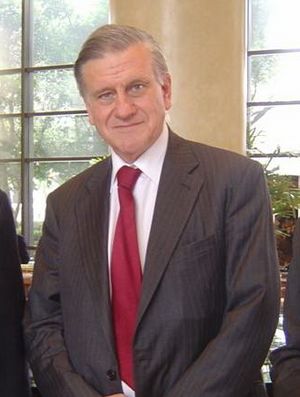
- Valentín Fuster: A Spanish cardiologist. He is the only cardiologist to receive the highest awards from the world's four major cardiovascular organizations. He is known for his research and patient care.
- Jose Maria Aznar: Served as the Prime Minister of Spain from 1996 to 2004. He is also on the board of directors for News Corporation.
- Antonio Cañizares Llovera: A Spanish Cardinal of the Roman Catholic Church. He was the Archbishop of Toledo and Primate of Spain. He received an honorary doctorate from CEU Cardenal Herrera University in 2006.
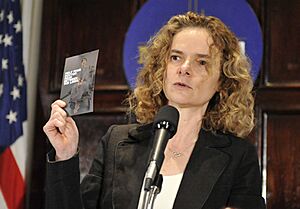
- Nora Volkow: Director of the National Institute on Drug Abuse (NIDA). She is known for her research on the brain.
- Joaquín Navarro-Valls: A doctor and journalist. He was the Director of the Holy See Press Office (Vatican Press Office) for many years. He was a key person in the Vatican during the time of Pope John Paul II.
- Bishop Carlos Belo: An East Timorese Roman Catholic bishop. He received the 1996 Nobel Peace Prize for his work towards peace in East Timor. He was awarded an honorary doctorate from CEU Cardenal Herrera University in 2004.
- Stanley G. Payne: A historian who studies modern Spain and European political movements. He is a Professor Emeritus at the University of Wisconsin–Madison.
- Andrea Riccardi: The founder of the Community of Sant'Egidio. He is also a Professor of Contemporary History at the University of Rome III. He served as a Minister in the Italian government.
- Stanley B. Prusiner: An American neurologist and biochemist. He is the director of the Institute for Neurodegenerative Diseases at University of California, San Francisco (UCSF). He won the Nobel Prize in Physiology or Medicine in 1997 for his work on prions, which are a type of infectious protein.
See also
 In Spanish: Universidad CEU Cardenal Herrera para niños
In Spanish: Universidad CEU Cardenal Herrera para niños



